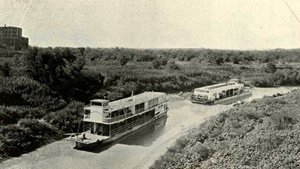By Frances James (1922 – 2019)
The city of East Dallas existed for seven short years (1882-1889), just east of the city of Dallas. Though its life was brief, it was home to many distinguished builders of Dallas. East Dallas was bom when the Houston and Texas Central and the Texas and Pacific railroads arrived in the area. Their tracks crossed near what is now Gaston and Central Expressway, creating a need for housing and jobs in the area. East Dallas extended from the eastern end of the present central business district to Henderson Avenue and from Ross Avenue on the north to the present State Fair Grounds on the south.
Two early settlers, W. H. Gaston and Jefferson Peak, owned many acres of farmland within East Dallas that became available for subdivisions after the Civil War. Other developments were started by Henry Boll and Jacob Nussbaumer, Swiss natives and survivors of the troubled LaReunion colony. Both had served in Nat Burford’s 19th Texas C.S.A. Cavalry. Several families of French, Belgian and Swiss immigrants settled in the area rather than return to Europe after LaReunion failed. By 1870, a second wave of European immigrants had bought most of the lots. Their concentration in East Dallas greatly benefitted its development.
In 1876, George W. Crutcher (1849-1922) came to Dallas from Eastland, where he had taught the first public school class. With two brothers, he established a successful real estate company. He was involved in the city of East Dallas for six of the seven years of its existence, serving as mayor for four years, and also holding the offices of city secretary and alderman. During his tenure as mayor, a system of first-class roads was built and a safe water supply was established. A school building was built in 1886 on the comer of Gaston and Hall, now the site of the Baylor Dental Clinic.
Haskell Avenue was named for Kentucky native Horatio Nelson Haskell, bom in 1825. After his service in the war with Mexico, he settled in Dallas County. He developed a 30-acre tract in East Dallas and was an alderman for six years. Joe Beeman was bom in Dallas in 1854 to William and Martha (Dye) Beeman, members of one of the earliest families to come to Dallas County, arriving in 1842. Joe was practicing his trade as blacksmith when he was elected marshal of East Dallas. As marshal, Joe also served as tax collector. Another notable person in East Dallas history was Colonel Christopher Columbus Slaughter (1837-1919). One of his lasting achievements was the establishment of Texas Baptist Sanitarium, the forerunner of Baylor Medical Center. Known as the Cattle King of Texas, he was a banker who also gave generously to help build many churches in Dallas. The Board of Directors at the hospital wanted the complex to bear his name, but he declined, noting what an inappropriate name “Slaughter” would be for a hospital.
| The State Fair and Exposition had its modest beginning during the period when the city of East Dallas was flourishing. The first location for this fair was on the present site of Baylor Hospital. A rival fair, call the Texas State Fair, opened on the same day at a site just north of Gaston and Hall streets, near McKinney and Haskell. W. H. Gaston purchased 80 acres of land in 1886 and deeded it to the Fair Association for 140 shares of stock which he later donated to the fair. The two groups soon merged and chose the current East Dallas site for the fairgrounds. Many acres have been added to this original purchase and the site is now a Dallas Historic District and a National Historic Landmark. East Dallas grew from 300 people when incorporated in 1882 to 6,000 when annexed to the city of Dallas in 1890. Dallas was the largest city in the state of Texas in the 1890 census due to this merger. This was the olnly time that happened. In a few short years, East Dallas, the small city that was carved from farmland, ad a lasting influence on Greater Dallas. |


